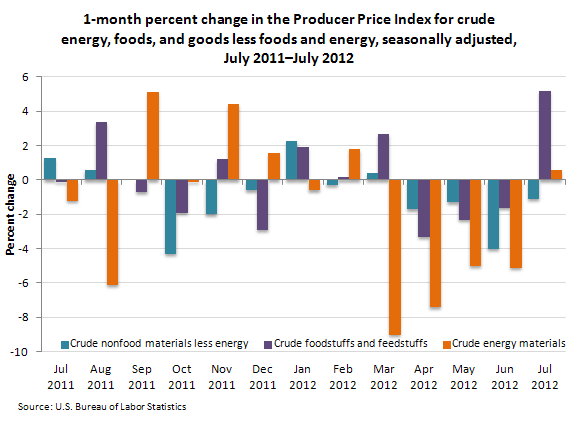August 15, 2012 (The Editor’s Desk is updated each business day.)
Producer Price Index in July 2012
The seasonally adjusted Producer Price Index for finished goods rose 0.3 percent in July, following a 0.1-percent increase in June and a 1.0-percent decline in May. The index for finished goods less foods and energy moved up 0.4 percent in July.

[Chart data]
The index for finished consumer foods advanced 0.5 percent in July, the same rate as in June. The index for finished energy goods moved down 0.4 percent in July, the fifth straight decrease. Most of the July decline in the energy index is attributable to prices for gasoline, which fell 3.1 percent.
At the earlier stages of processing, prices received by manufacturers of intermediate goods moved down 0.9 percent in July, and the crude goods index advanced 1.8 percent. Prices for crude nonfood materials less energy declined 1.1 percent in July, while prices received for crude foodstuffs and feedstuffs increased 5.2 percent and prices for crude energy materials climbed 0.6 percent.

[Chart data]
These data are from the BLS Producer Price Index program. To learn more, see "Producer Price Indexes — July 2012" (HTML) (PDF), news release USDL-12-1645. All producer prices are routinely subject to review once, 4 months after original publication, to reflect the availability of late reports and corrections by respondents.
Related TED articles
Prices
Of interest
Spotlight on Statistics: National Hispanic Heritage Month
In this Spotlight, we take a look at the Hispanic labor force—including labor force participation, employment and unemployment, educational attainment, geographic location, country of birth, earnings, consumer expenditures, time use, workplace injuries, and employment projections.
Read more »

